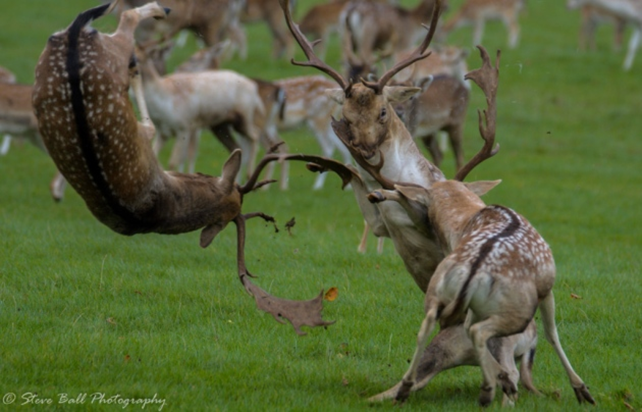Project Description
Conflict is widespread in the animal world because individuals often need to compete for the acquisition of resources that ensure survival or reproductive success. Fighting imposes costs in terms of time, energy, and the risk of injury or even death and theory predicts that, to mitigate these costs, fighters should gather information about their opponent’s fighting ability (e.g. Enquist et al. 1990); for example, through signals of their quality. By comparing their own quality to that of their opponent, contestants can then decide whether to continue fighting or quit; crucially, by gathering information at an early stage in the contest saves time and energy.
Because contests are public displays, bystanding non-combatants can also gather information on the fighting quality of potential opponents. On occasion, these bystanders approach and disrupt ongoing fights, known as third-party intervention behaviour (Bissonnette et al. 2015); however, how and why bystanders decide to intervene remains unclear. We have recently discovered that the probability of third-party intervention increases as the differences between fighting opponents in body and weapon size decrease (Jennings & Gammell 2022). But whether the body or weapon size of bystanders relative to the combatants mediates the decision to intervene is unknown although this is, at least theoretically, the case. Alternatively, social relationships might play a role in multi-party contest behaviour; thus, individuals may elect to intervene in contests containing unfamiliar rivals or to support close associates.
Using the fallow deer as a model species, this project will investigate outstanding questions on third-party intervention behaviour. Specifically, the fieldwork element of the project will empirically test whether phenotypic differences and social network position between individuals are associated with intervention behaviour. Because most models of intervention behaviour have been formulated without access to data, there is also the exciting possibility of generalising the findings of the field stage to developing new theoretical models of how social phenotypes influence bystander behaviour.
Study population and field site: The fieldwork will be conducted in the Phoenix Park, Dublin (Ireland) on a population of individually identifiable European fallow deer. The deer have been resident at the park since the 1600’s and fawns have been tagged annually since 1971 during the June birthing season. For the most part of the year, males and females maintain sexually segregated herds with mixing occurring during the October rut where most fighting is observed. The student will join a team of scientists including PhD students and staff from Queen’s University, Belfast.
Training: This project involves a range of cutting-edge methodological and analytical techniques. Training in observation and behavioural data collection of the deer will be given onsite at Phoenix Park. Training in photogrammetry to assess growth rates during the summer of both body and antlers will be undertaken at QUB. In addition, support and training in study design, social network analysis, and advanced statistics will be provided at QUB and through QUADRAT training.
CANDIDATE BACKGROUND
- A 2.1 degree in zoology, ecology, biology or related discipline is essential; a Masters, M.Sci or equivalent animal behaviour or other relevant discipline is highly desirable.
- The project requires a candidate with experience of data collection and research methods in the behaviour of free-ranging or captive populations, and strong statistical/quantitative skills.
- Given that the role will involve extended periods of fieldwork, the successful candidate must have initiative, independence, adaptability, resilience, troubleshooting skills, and self-motivation.
- Interested applicants are strongly encouraged to contact the lead supervisor (D .Jennings, d.jennings@qub.ac.uk) to discuss the project, and how they intend to develop it.
Photo credit: Steve Ball Photography
Supervisors
Dómhnall JenningsPrimary Supervisor: | Profile: Dómhnall Jennings Email: d.jennings@qub.ac.uk Institution: Queen's University, Belfast Department/School: School of Biological Sciences |
Greta BocediSecondary Supervisor: | Profile: Greta Bocedi Email: greta.bocedi@abdn.ac.uk Institution: University of Aberdeen Department/School: School of Biological Sciences |
Isabella CapelliniAdditional Supervisor: | Profile: Isabella Capellini Email: I.Capellini@qub.ac.uk Institution: Queen's University, Belfast Department/School: School of Biological Sciences |
References
Bissonnette, A., Perry, S., Barrett, L., Mitani, J. C., Flinn, M., Gavrilets, S., & de Waal, F. B. M. (2015). Coalitions in theory and reality: A review of pertinent variables and processes. Behaviour, 152, 1-56
Enquist, M., Leimar, O., Ljungberg, T., Mallner, Y., & Segerdahl, N. (1990). A test of the sequential assessment game: Fighting in the cichlid fish Nannacara anomala. Animal Behaviour, 40, 1-14
Jennings, D.J. & Gammell, M.P. (2022). Bystander fallow deer engage in in third-party behaviour based on similarities in contestant resource holding potential. Animal Behaviour, 191, 33-41
QUADRAT Themes
- biodiversity






















































